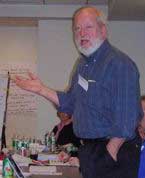[© Copyright. Feel free to link to this blog. Please ask author for permission before copying.]
[Co-Authored: William Bergquist and Steve Phillips]
There are three domains in which all teams must enter at one time or another. These three domains are information, intentions and ideas. These three domains relate directly to the three dimensions of problem solving: situation (information), target (intentions) and proposal (ideas).
The domain of information is entered whenever we attempt to find out more about the current condition in which we find ourselves. In soliciting information, leaders act as researchers, asking questions that can be answered by a systematic collection of information. For example, if a college wants to know which of four academic programs are potentially most attractive to a particular group of prospective students, then a sample of these students might be asked to indicate under what conditions they would be likely to enroll in each of these four programs. The information obtained is valid if the students have been honest, if the right questions were asked and if the sample used was representative of the entire pool of potential students. If the information is valid, then the college should be able to state with some confidence which of the academic programs is most attractive to this population of potential students.
In understanding the current situation, however, leaders must not only seek information that is valid. They must also seek information that is useful. It must relate to the target that the leader and her team wish to reach. Thus, if the target concerns increased financial viability for a college, then a market survey will be of little use, even if the information obtained were valid. It is only useful if the costs associated with each of the four programs also can be determined, along with the acceptable tuition levels for this population of students regarding each of the four programs. It is surprising to see how often information is collected that relates only marginally to the problem faced by an organization!
Many realistic plans can be established and problems can be solved through the systematic collection of valid and useful information. This lies at the heart of rational, linear planning and modern management processes. In other instances, unfortunately, effective leadership cannot exclusively be based on information about the current situation. Many organizational decisions, particularly those involving people rather than machines, center, at least in part, on conflicting goals, objectives or desired outcomes. Attention must shift from the domain of information to that of intentions. This domain is likely to be particularly important in today’s society, where conflict in values and purposes is so common.
The domain of intentions is entered whenever we attempt to understand and clarify an organization’s mission, vision, values or purposes. While research prevails in the area of information, clarification prevails in the area of intentions. Unlike traditional approaches to the clarification of intentions, which tend to emphasize enforcement or modeling, intention clarification focuses on the way in which mission, vision, values and purposes come into being. As we become clearer about our intentions, we will begin to produce solutions that are more and more consistent with these intentions. The process of clarifying intentions becomes richer and more profound as each of us moves toward greater maturity. A mature intention is freely chosen; it is not imposed (an imposed requirement is part of the situation). A mature statement of mission, vision, value and purpose is prized and affirmed; this statement serves as a guiding charter for one’s department or organization and is repeatedly acted on in a consistent and persistent manner.
The domain of ideas is entered whenever an attempt is made to generate a proposal intended to move from the current to the desired state. Ideas are sometimes fragile, often misunderstood, and easily lost. While information exists everywhere, we often ignore or misinterpret it. But we can usually go back and retrieve it. Similarly, even though intentions may be ignored or distorted, they resist extinction. Their resistance to change is often a source of frustration: old values linger as do old visions and purposes. Good ideas, on the other hand, are easy to lose and hard to recover.
Settings must be created in which ideas can readily be generated and retained. Two processes are essential. Divergence produces creative ideas. Divergence requires a minimum censorship of ideas, minimal restriction on people offering their own suggestions and taking risks, and minimal adherence to prescribed rules or procedures for the generation of new ideas. The second process is convergence. People must be given the opportunity to build on each other’s ideas, to identify similarities in their ideas, and to agree upon a desired course of action. Convergence requires leaders to observe specific rules and procedures, to listen to ideas and to be constructively critical of other ideas. The domain of ideas often requires leaders to display a subtle and skillful interplay between convergence and divergence.



 Posted by William Bergquist
Posted by William Bergquist 